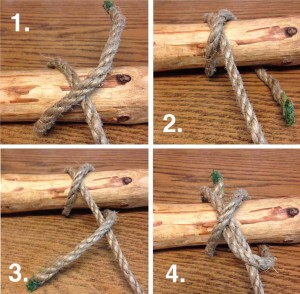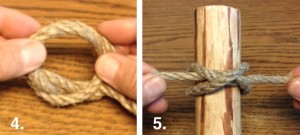In the days when black powder was used for blasting in mining operations, this was the knot that was tied around the top of the bag containing the black powder to hold the fuse in securely—hence, it’s other common name, the bag knot.
 The constructor is based on the clove hitch, except after the first half hitch, the running end forms an overhand knot with the standing part. It’s this extra half-knot that provides additional hold when the hitch is pulled tight.
The constructor is based on the clove hitch, except after the first half hitch, the running end forms an overhand knot with the standing part. It’s this extra half-knot that provides additional hold when the hitch is pulled tight.
1) Make a turn around the spar with the running end, then cross over the standing part of the rope.
2) Bring the running end under the spar.
3) Cross the running end on the outside of and over the standing part.
4) Form an overhand knot by passing it underneath the half hitch.
To tie a Constrictor Knot in the standing part of the rope over an open spar:
1) Make a right overhand loop.
2) While holding the left side of the loop, twist down on the right side counter clockwise making a right underhand loop.
3) Place this second loop behind the standing part and pass it under the first loop.
4) Grab hold of both loops and place then over the spar.
5) Pull tight.
- To use interchangeably with a clove hitch, except once the constrictor knot is pulled tight, it is quite hard to untie.
- To start a lashing. When it’s tied to a vertical spar, the crossing spar can rest on it while the lashing is being made.
- To make a good temporary whipping at the cut end of a rope, or to start the West Country whipping.
- To start a splice, use it to stop off the unlaid strands of the rope so they won’t unravel further as you’re working the splice.

